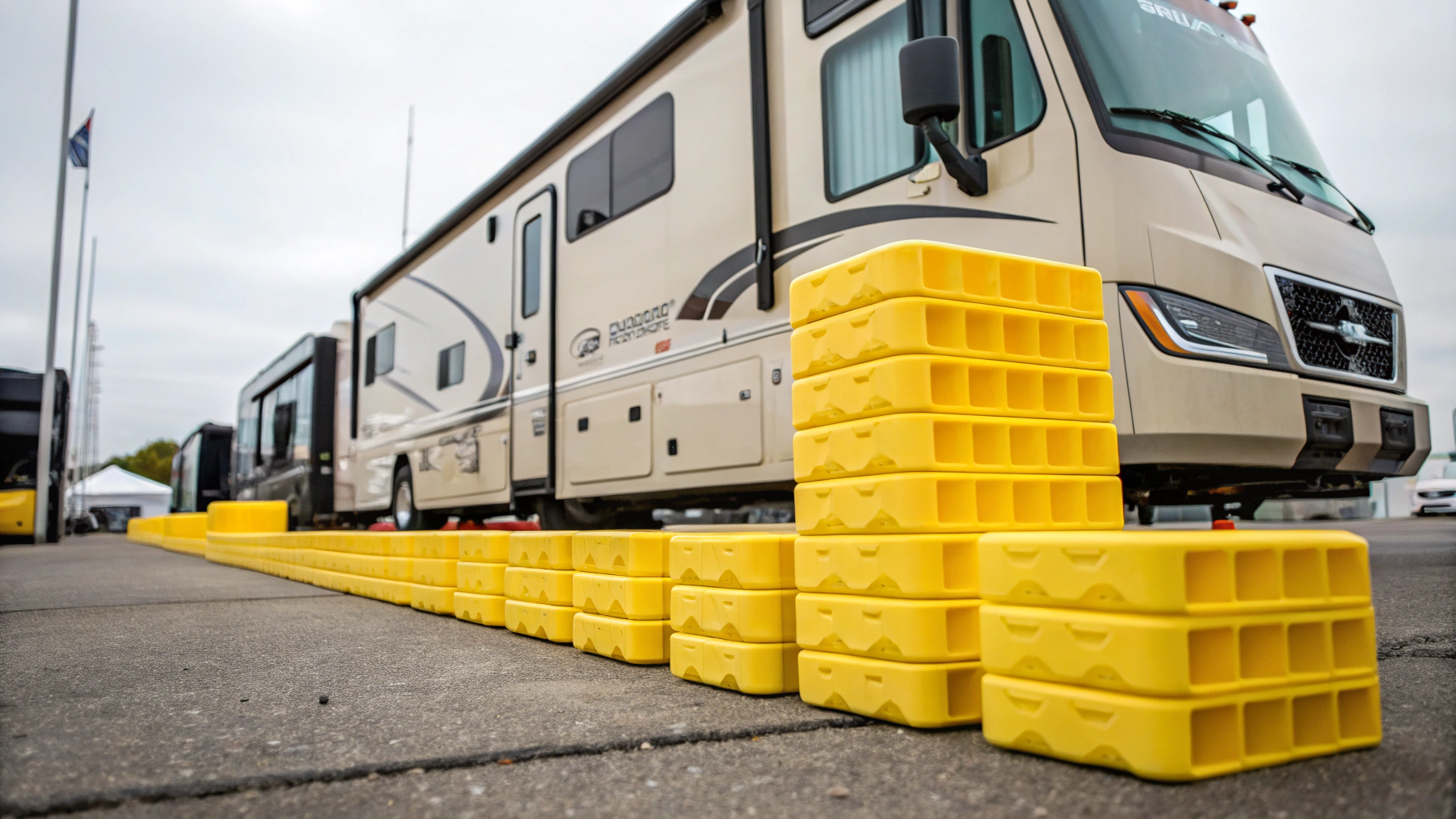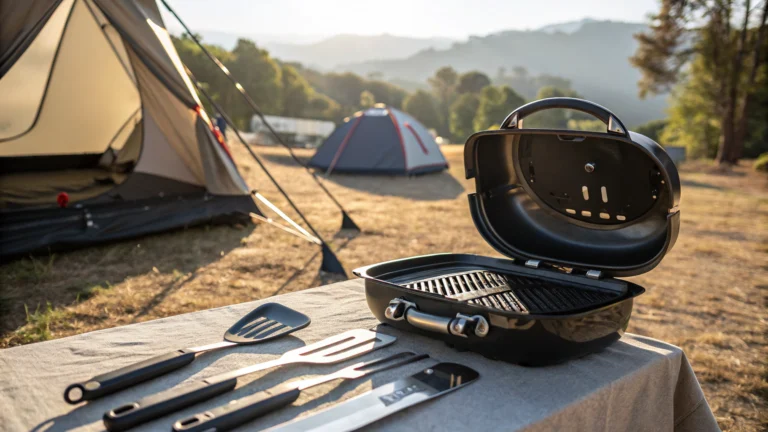Best RV Leveling Blocks for Easy, Stress-Free Parking
Table of Contents
Embarking on an adventure with your RV requires the right equipment to ensure your journey is smooth and enjoyable. Among these essentials are RV leveling blocks, which are vital for achieving stability and comfort when parking on uneven terrain.
Understanding the importance of RV leveling blocks can significantly enhance your camping experience. They not only protect your RV’s integrity but also ensure that your appliances function correctly and provide you with a comfortable living space.
Best RV Leveling Blocks for Your Travel Needs
Interlocking Blocks
Interlocking RV leveling blocks have become increasingly popular among RV enthusiasts for their versatility and ease of use. These blocks function much like building bricks, allowing you to create custom heights by stacking and interlocking them together. The modular design makes them adaptable to various terrains and leveling requirements. Most interlocking blocks feature bright colors for visibility and are made from durable, high-impact plastic that can withstand significant weight loads without cracking or breaking down.
Stackable Blocks
Similar to interlocking options, stackable RV leveling blocks offer simplicity and effectiveness. These blocks can be placed on top of each other to achieve the desired height. The primary difference is that stackable blocks don’t have interlocking mechanisms, making them slightly less stable for extreme situations but often more affordable. They’re typically lightweight and easy to store, making them a popular choice for smaller RVs and casual travelers.
Ramp-Style Levelers
Ramp-style RV leveling blocks provide a gradual incline for your tires to roll up onto, offering a smooth transition to the required height. These levelers are particularly useful for larger motorhomes and fifth wheels. The primary advantage is the ease of use—simply drive up until you reach the desired level. Many ramp-style levelers include built-in wheel chocks for added security once positioned. They typically handle greater weight capacities but take up more storage space than block alternatives.
Material Considerations
The material of your RV leveling blocks significantly impacts their durability and performance. Most premium options are constructed from high-density polyethylene or similar plastics that offer excellent resistance to UV exposure, extreme temperatures, and moisture. Metal options exist but are less common due to their weight and susceptibility to rust. When selecting RV leveling blocks, look for non-slip surfaces and reinforced construction that can handle your specific RV’s weight without deformation over time.
How to Use RV Leveling Blocks Correctly
Pre-Parking Assessment
Before attempting to level your RV, take time to assess the parking area. Walk around and identify the highest and lowest points of the ground. This initial survey will help you determine where RV leveling blocks are needed and approximately how many you’ll require. If possible, position your RV so that the lowest side is facing slightly uphill, making the leveling process more manageable. Also, check for soft ground that might compress under weight, potentially compromising your leveling efforts.
Side-to-Side Leveling First
Always begin with side-to-side leveling before addressing front-to-back adjustments. Place your RV leveling blocks in position before driving onto them. For optimal results, have a spotter guide you as you slowly drive onto the blocks. Once positioned, use a quality bubble level or electronic level placed on the floor inside your RV to verify you’ve achieved proper side-to-side levelness. Make adjustments by adding or removing blocks as needed until you achieve balance.
Front-to-Back Leveling
After completing side-to-side leveling, address any front-to-back imbalance using your RV’s built-in leveling system or stabilizing jacks. For travel trailers, adjust the tongue jack height accordingly. Remember that RV leveling blocks aren’t typically needed for front-to-back adjustments unless you’re dealing with extremely uneven terrain. Take your time with this process, as rushing can lead to improper positioning that affects comfort and system functionality.
Securing Your Position
Once your RV is properly leveled, always secure your position by engaging the parking brake and placing wheel chocks around tires that aren’t on RV leveling blocks. This prevents any unexpected movement, especially on sloped terrain. For extended stays, periodically recheck your level status as settling can occur over time, particularly after rain or on softer ground. Small adjustments may be necessary to maintain optimal levelness throughout your stay.
Crucial RV Leveling Tips for Beginners
Weight Distribution Matters
Proper weight distribution plays a crucial role in effective leveling. Be mindful of how weight is distributed throughout your RV, including water tanks, stored supplies, and passenger placement. Uneven weight distribution can create leveling challenges and potentially exceed the capacity of your RV leveling blocks. For motorhomes with slide-outs, always level first, then extend the slides to prevent potential damage to the slide mechanisms.
Maintain Proper Block Placement
Position your RV leveling blocks to ensure full tire contact. Partial contact can lead to tire damage or block failure. Additionally, ensure blocks are placed on firm, stable ground. Avoid placing them on loose gravel, mud, or sand without first creating a solid foundation. Some RVers carry plywood boards to create a stable base for their blocks on particularly challenging surfaces.
Consider Weather Conditions
Weather conditions can impact your leveling setup. In rainy environments, ground may soften and cause shifting. In hot conditions, asphalt might deform under the pressure of leveling blocks. Always account for potential weather changes during your stay and be prepared to make adjustments as needed. Quality RV leveling blocks should be able to withstand various environmental conditions without deteriorating.
Practice Makes Perfect
Like many aspects of RV life, leveling becomes easier with practice. Consider practicing in your driveway or a level parking lot before heading out on your adventures. This allows you to become familiar with your specific RV’s leveling requirements and the process of using your chosen blocks. Many experienced RVers develop a personal system that works efficiently for their particular setup.
Investing in quality RV leveling blocks and taking the time to use them correctly will significantly enhance your camping experience. With stability comes comfort, proper functioning of appliances, and protection of your valuable RV investment. Whether you choose interlocking blocks, stackable options, or ramp-style levelers, understanding the fundamentals of proper leveling will serve you well throughout your RV journeys.
As an Amazon Associate we earn from qualifying purchases.
Shop Related Products:
- Find RV leveling blocks on Amazon
- Find RV chocks on Amazon
- Find bubble levels on Amazon
- Find RV wheel stabilizers on Amazon
- Find RV jacks on Amazon
By properly using RV leveling blocks, you can ensure a stable and safe parking setup, which makes your RV travels more enjoyable. Invest in high-quality leveling tools to protect your RV and enhance your camping experience.
RV leveling blocks, while seemingly minor, are a crucial component in maintaining the comfort, safety, and functionality of your RV setup. They ensure that from the ground up, your RV is always in the best position possible.
Frequently Asked Questions
How do I choose RV leveling blocks?
Consider weight capacity, block material, and surface compatibility. Ensure the blocks can support your RV’s weight, are made from durable UV-resistant materials, and are appropriate for the surfaces you typically camp on. Also consider storage space and ease of use when making your selection.
What types of RV leveling blocks are available?
Options include interlocking blocks, stackable blocks, and ramp-style levelers. Interlocking blocks connect like puzzle pieces for customizable heights. Stackable blocks are simple platforms that can be stacked to reach desired heights. Ramp-style levelers provide a gradual incline for your tires and are particularly useful for larger RVs.
Are RV leveling blocks necessary?
Yes, they ensure stability, comfort, and protect RV systems. Level positioning is essential for proper refrigerator operation, comfortable sleeping, and reducing strain on your RV’s structure. Leveling blocks also help prevent doors and drawers from swinging open and can improve water drainage from your roof during rain.




